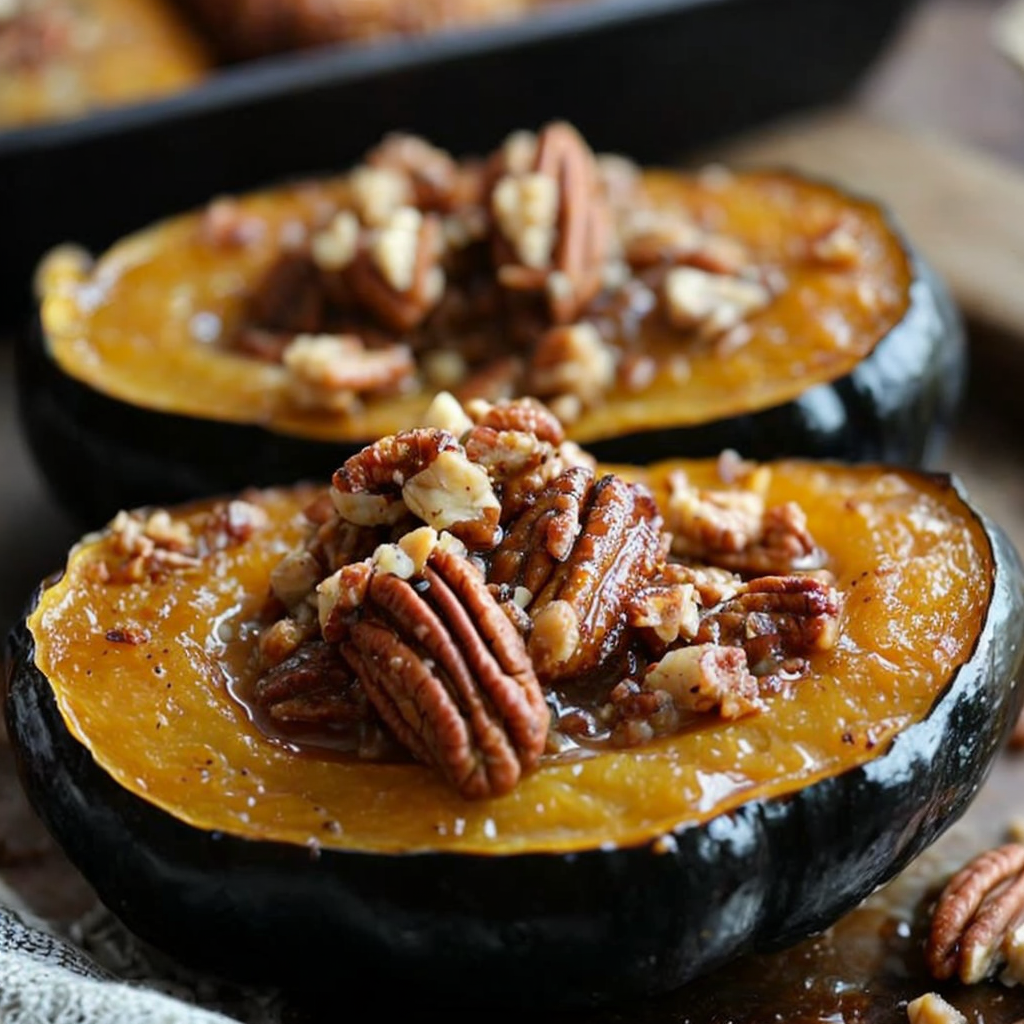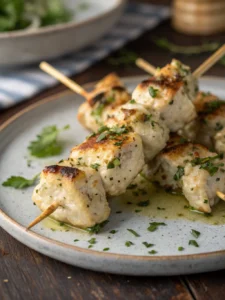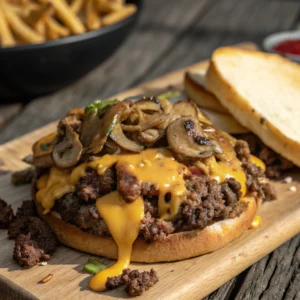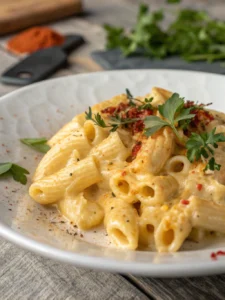Easy Maple Pecan Roasted Acorn Squash: A Family Favorite Recipe
Maple Pecan Roasted Acorn Squash is a delightful autumn dish that quickly became a family favorite in our household. The combination of sweet maple syrup and crunchy pecans with the natural flavors of acorn squash creates a perfect balance of sweetness and texture. The rich, earthy aroma that fills the kitchen while the squash roasts is simply irresistible, making it an ideal dish to gather your loved ones around the dinner table.
Quick Recipe Highlights
- Flavor Profile: The sweet, nutty flavor is enhanced by the rich undertones of maple syrup and the buttery texture of pecans, creating a harmonious taste.
- Texture: Each bite offers a soft, tender squash contrasted with the crunchy pecans, delivering a satisfying mouthfeel.
- Aroma: Inviting aromas of toasted nuts and caramelized maple infuse the air with warmth and comfort.
- Visual Appeal: This dish showcases a vibrant orange squash, beautifully accented by deep brown pecans, adding a touch of elegance to any dinner spread.
- Skill Level Needed: Ideal for beginners, this recipe requires basic culinary skills, making it accessible for home cooks of all levels.
- Special Equipment: A baking sheet and mixing bowl are all you need, with no special tools necessary.
Recipe Overview
- Difficulty Level: This easy recipe is perfect for novice cooks, as it requires simple preparation steps and minimal ingredients.
- Category: Perfect as a side dish, this recipe complements a variety of main dishes, from roasted meats to vegetarian fare.
- Cuisine: Blending elements of American comfort food, this dish is influenced by classic fall flavors and traditions.
- Cost: With a budget-friendly ingredient list, this recipe is accessible for families seeking delicious and economical meal options.
- Season: Perfect for fall, this dish takes advantage of seasonal squash and pecans, aligning with harvest-time flavors.
- Occasion: Ideal for family gatherings, holiday dinners, or a comforting weeknight meal, this dish suits any occasion where warmth and coziness are desired.
Why You’ll Love This Recipe
The taste of Easy Maple Pecan Roasted Acorn Squash is simply exquisite. The sweet maple syrup perfectly complements the natural sweetness of roasted acorn squash. Add in the nutty pecans, and you have a dish that’s both indulgent and healthy. This recipe is not only about its flavor but also its incredible texture, combining soft, melt-in-your-mouth squash with crunchy, toasted nuts.
Convenience is another wonderful feature of this recipe. With just a few minutes of prep time and straightforward roasting, this dish offers minimal fuss in the kitchen, making it perfect for busy weeknights or a last-minute side for holiday gatherings. It’s an easy way to bring impressive flavor to your table without extensive effort.
The nutritional profile of this dish is commendable. Acorn squash is rich in vitamins A and C, providing essential nutrients and dietary fiber, while pecans offer healthy fats and proteins. The moderate use of maple syrup means it doesn’t compromise on healthiness, letting you enjoy this sumptuous recipe guilt-free.
For social occasions, the Easy Maple Pecan Roasted Acorn Squash is a showstopper. Its vibrant visual appeal and delectable flavor make it a conversation piece at potlucks or dinner parties. Its universal appeal means it can be a hit across varied palates, from children to adults.
Lastly, this dish is incredibly cost-effective. With acorn squash and pecans being relatively affordable, especially during fall harvests, it’s a budget-friendly recipe that doesn’t sacrifice quality or taste. It’s accessible to cooks looking to maximize flavor while keeping costs in check.
Historical Background and Cultural Significance
Acorn squash has its roots in ancient American agriculture. Native to North America, this nutrient-rich vegetable has been a staple for centuries. Its long shelf life and ease of cultivation made it a favored plant among indigenous peoples who valued its nutritional benefits well before European settlers arrived.
The introduction of pecans and maple syrup into this squash recipe is a testament to American culinary evolution. Pecans, another native to North America, are deeply integrated into Southern cooking traditions where they bring richness and depth to dishes. Maple syrup, on the other hand, is a gift from the Northeastern native tribes who perfected its extraction and use; it has since become a quintessential part of the North American flavor palette.
Over the decades, the combination of acorn squash with pecans and maple syrup has evolved as a part of festive American sides, particularly in autumn and winter. It’s in the holiday season and fall meals where these flavors converge, representing bounty and togetherness with each savory, sweet bite.
Regional variations have added unique twists to this dish. In Southern kitchens, spices like cinnamon or nutmeg may be added, while up North, chefs might introduce a hint of vanilla or bourbon. Each adaptation reflects local ingredients’ availability and community tastes, enriching its already storied background.
Ingredient Deep Dive
Acorn squash is more than just a culinary delight; it’s a nutritional powerhouse. Steeped in cultural significance, this squash variety was revered for its versatility and storability by Native Americans. Packed with beta-carotene, vitamin C, and fiber, acorn squash offers numerous health benefits. When selecting acorn squash, choose those that are heavy for their size and have a vibrant green skin without blemishes. Store them in a cool, dry place to maintain freshness, avoiding refrigeration until they’re cut. If acorn squash isn’t available, butternut squash or kabocha can make suitable alternatives.
Pecans not only add a delightful crunch to the recipe but also come with a history rooted in Native American cuisine. This indigenous nut of North America contributes heart-healthy fats, protein, and essential minerals like magnesium and zinc. When buying pecans, look for fresh, whole nuts without any signs of mold. They should be stored in the refrigerator or freezer to preserve their natural oils. Walnuts or hazelnuts can serve as substitutes if pecans aren’t to your taste.
Common Mistakes to Avoid
- Skipping squash washing: Ensure you thoroughly wash the squash to remove any dirt or pesticides before cooking.
- Incorrect squash slicing: Use a sharp knife to slice the squash evenly for consistent cooking.
- Using cold syrup: Allow syrup to sit at room temperature before drizzling to ensure even coating and better absorption.
- Overcrowding the pan: Give squash slices ample space on the baking sheet to caramelize properly.
- Neglecting nut toasting: Toast pecans lightly to release their oils and enhance flavor.
- Forgetting to flip squash: Midway through roasting, flip pieces to ensure even browning on both sides.
- Inaccurate timing: Keep an eye on the squash to avoid overcooking and drying out.
- Ignoring flavor balance: Taste and adjust maple syrup as needed, considering the squash’s natural sweetness.
- Not allowing cooling time: Briefly let the dish cool; this enhances flavors and makes handling easier.
- Improper storage: Store leftovers properly to maintain freshness and prevent spoilage.
Essential Techniques
Mastering even squash slicing is crucial for uniform texture and cooking. Use a sharp, large chef’s knife and slice slowly to ensure consistent, even pieces. This prevents smaller pieces from overcooking while larger ones are still tough. Additionally, perfecting maple syrup drizzling can elevate your dish. Pour syrup slowly and evenly across the squash, focusing on covering them without soaking. This technique ensures each piece caramelizes perfectly while retaining a delightful glaze.
Pro Tips for Perfect Easy Maple Pecan Roasted Acorn Squash
For the best flavor, opt for fresh, local acorn squash during its peak season in the fall. This ensures the most vibrant taste. Lightly toast the pecans before adding them, enhancing their flavor and bringing a roasted aroma to the dish. When roasting, turn the squash halfway through to promote even caramelization on all sides. If you prefer a stronger nutty flavor, toss the pecans in a touch of melted butter before baking.
To make the dish more savory, add a pinch of sea salt over the squash before drizzling with maple syrup. Experiment with adding a dash of freshly ground cinnamon or nutmeg for a warm, spicy undertone. If you’re preparing this dish for a crowd, cook in batches rather than overcrowding the pan to ensure every piece roasts to perfection.
Variations and Adaptations
Depending on your regional influences, you can easily adapt this dish. In Southern recipes, adding a hint of bourbon to the maple syrup creates a richer depth of flavor. For seasonal variations, try replacing acorn squash with winter squash varieties such as butternut or delicata to take advantage of their unique tastes and textures.
For dietary modifications, use a sugar-free maple syrup alternative to create a low-carb version of this recipe. For a flavor twist, you could replace pecans with walnuts or add dried cranberries for a tart contrast. In terms of texture, consider adding a breadcrumb or oat crust over the squash slices for a heartier, chewy component.
Presentation alternatives might include serving the roasted squash halves on a large platter as a shared side or cutting them into manageable wedges for individual plates, making it a versatile dish visually.
Serving and Presentation Guide
To plate this dish elegantly, arrange the roasted squash slices in a fan pattern on a serving platter, then sprinkle pecans evenly over them. If you desire, add a few sprigs of fresh rosemary as a garnish for color contrast. This dish pairs well with roasted or grilled main courses, such as chicken or pork, or an autumn salad of mixed greens and dried fruits. Serve warm, and consider placing a small bowl of extra maple syrup on the table for guests to customize their sweetness level. Keep portions moderate, as the squash’s sweetness and the pecan’s richness can be quite filling.
Wine and Beverage Pairing
This sweet and savory dish pairs excellently with a crisp Chardonnay or a lightly oaked Viognier, whose citrus and melon notes provide a refreshing contrast to the robust flavors of the squash and pecans. A non-alcoholic option could be freshly brewed apple cider or a sparkling water with a hint of lemon or lime. Avoid overpowering beverages, which might overshadow the dish’s nuanced flavors.
Storage and Shelf Life
Store any leftovers in an airtight container in the refrigerator for up to three days. Reheat the squash gently in the oven at low temperature to maintain its texture and enhance the flavors without drying. While freezing is not recommended due to texture changes in the squash, it can be done if necessary, ensuring a tightly sealed freezer bag is used. Thaw overnight in the refrigerator then reheat, checking for signs of spoilage before serving.
Make Ahead Strategies
This recipe is perfect for making ahead of time, enhancing its flavor and ease of preparation. You can prepare the squash slices and pecans up to two days in advance, storing them separately. When ready to cook, simply drizzle with the maple syrup and roast. Consider assembling the dish entirely and reheating it at the time of serving, though adding fresh pecans or a final drizzle of syrup post-reheating can elevate its freshness.
Scaling Instructions
Doubling this recipe for a larger gathering is straightforward. Use a larger baking sheet or roast in two batches to ensure each piece is evenly caramelized. For smaller families or portions, halving the recipe will give you just enough to enjoy without leftovers. Ensure equipment adjustments, such as using multiple baking pans, and slightly reduce cooking time as less squash may require less time to roast evenly.
Nutritional Deep Dive
This dish offers a balanced mix of macros with a healthy level of carbohydrates from the squash, precious healthy fats from the pecans, and a modest amount of protein. Rich in vitamins and antioxidants, such as vitamin A and E, it supports eye health and immune function. Each serving provides an excellent source of fiber and is both filling and nourishing as part of a balanced diet. For weight management, be mindful of portion size, considering the dish’s calorie density.
Dietary Adaptations
For gluten-free adaptation, there is no change necessary as the recipe is naturally without gluten. To accommodate a dairy-free diet, use coconut or avocado oil instead of butter for toasting pecans. For a vegan preparation, ensure the syrup is pure maple syrup without any added ingredients. Keto adherents could explore using a low-carb syrup replacement to fit dietary needs precisely. Each dietary adaptation allows delicious enjoyment of this recipe for various restrictions.
The Recipe
Easy Maple Pecan Roasted Acorn Squash
Serves: 4
Prep Time: 10 mins
Cook Time: 40 mins
Total Time: 50 mins
Kitchen Equipment Needed
- Baking sheet
- Sharp knife
- Mixing bowl
Ingredients
- 2 medium acorn squashes
- 1/3 cup maple syrup
- 1 cup pecans, roughly chopped
- 2 tablespoons butter (or alternative for dairy-free)
- Salt to taste
- Optional: dash of cinnamon or nutmeg
Directions
- Preheat the oven to 375°F (190°C).
- Cut the acorn squashes into halves and remove the seeds. Slice each half into 1-inch thick slices.
- In a mixing bowl, combine maple syrup, melted butter, and a pinch of salt. Optionally add cinnamon or nutmeg.
- Place squash slices on a baking sheet and brush with half of the syrup mixture.
- Roast in the oven for 20 minutes, flip slices, brush with remaining syrup, and sprinkle with pecans.
- Roast for an additional 20 minutes or until squash is tender and caramelized.
- Remove from oven and let cool for a few minutes before serving.
Recipe Notes
- To enhance flavor, add a splash of vanilla extract to the syrup mixture.
- For a savory twist, sprinkle finely chopped herbs like rosemary over the squash before serving.
Troubleshooting Guide
For texture issues, if the squash turns out mushy, reduce the cooking time and check doneness with a fork. To address flavor imbalances, adjust the syrup quantity; too much sweetness can be balanced with a sprinkle of salt. Ensure oven temperature accuracy to solve temperature-related problems, using an oven thermometer if necessary. If equipment challenges arise, consider upgrading your baking sheet for even heat distribution. For ingredient substitutions like maple syrup, honey may be a viable alternative, but it will alter the sweetness profile. Watch timing to avoid burnt nuts; add them later if needed to prevent over-roasting.
Recipe Success Stories
Many of our community members have shared their variations and successes with this dish. One reader suggested adding a sprinkling of blue cheese crumbles on top for a gourmet twist. Others have enjoyed photography tips, ensuring the dish’s vibrant colors are beautifully captured. Some have ventured into using different nuts, with hazelnuts providing a delightful, aromatic edge. The recipe’s flexibility continues to inspire creative home cooking explorations.
Frequently Asked Questions
Can I use a different type of squash?
Absolutely. While acorn squash works best due to its flavor profile and texture, butternut or kabocha are excellent substitutes.
Is it necessary to peel the squash?
No, the skin of acorn squash becomes tender upon roasting, making peeling unnecessary and saving time.
How can I store leftovers?
Store in an airtight container and refrigerate for up to three days. Reheat gently to preserve flavor and texture.
Can I add more spices?
Yes, personalization is encouraged. Consider adding spices like cloves or even cayenne for a spicy kick.
What is a good side dish pairing?
A fresh green salad or a simple quinoa dish complements the rich flavors beautifully.
Can this dish be made vegan?
Yes, opt for plant-based butter alternatives, ensuring the dish aligns with vegan standards.
Will other nuts work besides pecans?
Be creative. Walnuts, almonds, or hazelnuts can provide unique flavors and textures.
How important is the roasting time?
Roasting time is crucial for developing flavors and achieving the right texture; adjust as necessary based on squash thickness.
Should I cover the squash while roasting?
For optimal caramelization, leave the squash uncovered to allow the sugars to develop a glaze.
How can I tell when the squash is done?
A fork should easily pierce the flesh, with the edges turning a beautiful golden brown.
Additional Resources
Explore related recipes that accompany this dish well, such as roasted root vegetable medleys or simple herb-butter roasted chicken. Visit our technique guides for perfect roasting tips and how to toast nuts properly. We also recommend resources on seasonal squash, along with equipment suggestions for the best baking results.
Join the Conversation
Engage with us and other food enthusiasts on our social media channels. We love seeing your takes on the recipe; follow us for more photography tips to capture your culinary creations. Don’t forget to leave a review and share your variations or techniques that worked best for you. Join our community discussions to exchange ideas and inspiration!



